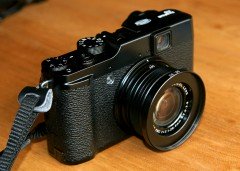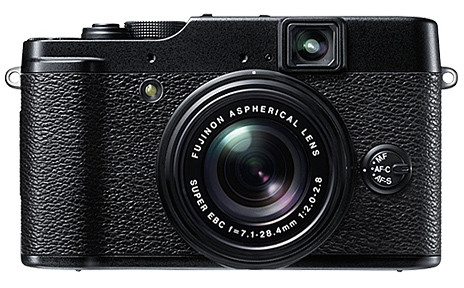
With Fujifilm Finepix X100 already hitting the chart-busters owing to its amazing picture quality, now it’s time to witness the advanced features and high end performance of the successor in Fujifilm X-series — Fujifilm Finepix X10. Fujifilm Finepix X10 is an advanced compact camera targeted at sincerely promoting the tagline of X-series — Take your passion for photography to the next level. The camera is a refined example of design, style and quality. Fujifilm X10 features 2/3″ 12 MP EXR CMOS sensor powered by EXR processor which renders enhanced sensitivity, minimal noise and high speed performance. This marks the beginning of the story of this modern classical. Here are 5 ultimate reasons (features) to fall in love with this finest example of Fujifilm’s craftsmanship.
-
High Quality Lens
Fujifilm Finepix X10 comes packed with Fujinon 4x optical zoom with its zooming range varying between 28mm wide to 112mm telephoto. To ensure high image quality, Fujinon has worked really well on providing quality optics. The lens design incorporates an arrangement of aspheric lenses, ED lenses and high-refractive index lenses which are treated with Fujinon’s Super EBC (Electron Beam Coating) to deliver sharp images while eliminating the possibilities of chromatic aberration and other lens flaws.

Fujifilm Finepix X10: Front View
-
High Precision Viewfinder
The bright viewfinder featured by the camera makes it a pleasure to look at the world through it. It’s optical zoom viewfinder offers superior brightness, a superb field of view and 85% frame coverage which enables you to view and frame every detail of the scene with precision.

Fujifilm Finepix X10: Rear View
-
Nothing Less Than Perfect Ergonomics
On the design front, Fujifilm Finepix X10 can be classified as the luxury camera with enhanced operability. It can be viewed as the most thought out piece of craft where everything right from the dial control to one-touch control function and RAW button all fall into the place. The intuitive design of X10 makes it an easy to use tool for photographers. It’s precision-milled ring and dials, die-cast magnesium top and base and leather like finish not only renders style. These design elements take the durability of the product to top notch.

Fujifilm Finepix X10
-
Exciting Shooting Modes
Fujifilm Finepix X10 is a premium compact camera which features exciting shooting modes. Ranging from ready to use auto modes to highly sophisticate manual mode, the camera provides the users with multiple options which simplify the process of taking great photographs. Along with providing auto-modes for photographing the portraits, landscapes, macro-shots, night scenes and sports, Fujifilm Finepix X10 provides the auto-modes for tricky subjects / scenes like fireworks, sunset, snow, beach, flower and underwater as well. Taking of the manual modes, the camera provides the semi-auto modes (Program, Aperture Priority and Shutter priority) and full manual mode as offered by DSLRs. Alongside the the camera also provides the advanced modes for creating 360° panoramas and photographing shallow DOF without having to set the sweet spot manually. The options don’t end up here. The camera also shoots in RAW format and features in-camera RAW processing to truly take your passion of photography to the next level.
-
Film Simulation Mode
The camera offers a film simulation mode which enables you to simulate the colors and tonal quality of color reversal film types loved by professional photographers. It provides three modes — Provia for natural colors, Velvia for vibrant colors and Astia for soft look; to get creative with color photography and 4 in-built filters for replicating the effects of monochromatic film photography. The classic look of these modes is also achievable through bracketing as well. Along with the specific film simulation modes, the camera also features film simulation bracketing through which a single exposure produces three images of the scene with Provia, Velvia and Asia effect respectively.
All these features together make Fujifilm Finepix X10 a creative tool in the hands of a photographer. Other features which make this camera the talk of the town are:
- Amazing low light performance with ISO sensitivity extendible upto 12800.
- High speed performance allowing you to capture 10 fps in continuous shooting mode.
- Dreamy soft focus effect achievable due to adoption of 7 blade aperture diaphragm.
- Electronic horizon leveling guage which makes it easy to align the image with the true horizon.
Power packed with a host of features and the promise of delivering superb picture quality, you can bring home Fujifilm Finepix X10 for $599.65 approx. Get it here!


I’m a pro shooter and have owned the X10 for about a year. This is an amazing little beast and is all I carry when not shooting professionally! But this retro-rangefinder-looking little dude comes at a price.
I have never had to learn so much finesse of a camera as this one requires. It has a host of “gotchas” which require constant attention when shooting.
1) Watch the controls! As a people shooter, if I’m shooting auto mode, I shoot aperture-preferred. However, with this little one I found that not being able to see my shutter speeds in the viewfinder was leading me to blurry photos under lower light; I just wasn’t seeing my speeds drop below 1/60! I’ve since switched to shooting shutter preferred and that has helped!
2) Watch that Autofocus switch! The AF switch, while in the same location as on my Nikons, is very easy to flip to Manual Focus! Get used to checking the focusing “square” on the LCD screen and recognizing when it has been flipped to manual.
3) Lastly…and this is a biggy…this camera has what could be called Control Caveats galore! As in…”you can use this control….unless you have this or this set…if you have those set this control won’t function…” There are too many to go into…but you get the idea. An example is when and when NOT the flash will function.
I was shooting RAW files thinking Lightroom would be a great post-processor. What I found is pretty horrendous noise. I shot some side-by-side JPEG/RAW files and found the JPEGs come out of the camera looking fantastic. Let’s face it, do you really need to shoot RAW files out of your Happy Snaps camera? I don’t think so, anyway. I was taught a JPEG workflow back in ’03 with Will Crockett and Fuji. Before that, as a chrome shooter, I learned to nail my exposures in-camera. So, getting spot-on JPEG files is a standard for me!
Speaking to Fuji: In 2003, when I began shooting digital, Fuji had introduced the S2. It was essentially an N80 Nikon with a Fuji sensor, guts and software. And it Rocked! I was shooting at ISO 1600 allowing the photojournalist in me (yes, I was actually a photojournalist for many years) to shine through! My Nikon colleagues were blown away with the low-noise at 1600; they couldn’t go above 400 even with their $5,000 bodies! So, in a nutshell, I’ve been a Fuji fan for almost 10 years!
Finally, if you do buy this camera, you’re going to have to train with it and learn all it’s nuances! If you do, you’ll end up with a rocking little camera which you’ll carry everywhere. People will think it’s an old rangefinder film camera and you’ll look cool!
One last note: It’s ridiculously spendy and incredibly poorly designed but get the lenshade. I put a 52mm Nikon thin UV filter on for protection. The design itself is flawed (there are slots which are behind the filter rings which allows moisture, dirt, snow, etc. to end up behind the very filter put there for protection!) I’ve tried to discuss this with Fuji but they do not seem to get it.
Here’s my own little review along with sample images (and some pics I shot at my buddy’s wedding):
http://www.blog.litfoto.com/index.php/2011/12/camera-test-images-fujifilm-x10/
http://www.blog.litfoto.com/index.php/2012/09/spencer-jessica-with-fuji-x-10/
Regards from Colorado!
Matt Lit
photographer & photography educator (Colorado Mountain College)